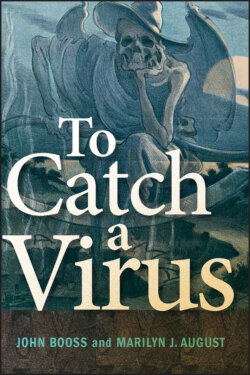Читать книгу To Catch a Virus - John Booss - Страница 22
Arthropod-Borne Diseases, Yellow Fever, and Epidemic Encephalitides: Monkeys and Mice
ОглавлениеThe experiments of Walter Reed et al. and the Yellow Fever Commission in Cuba following the Spanish-American War were conducted with human volunteers. Reed and Carroll’s studies on the filterable agent (50), while confirmed by others, could not be carried further because of the ethical objections to use of human volunteers in potentially lethal experiments. Hence, while extraordinary progress was made in control of the yellow fever due to the work of William Crawford Gorgas in controlling the mosquito vector (24), little progress was made in either laboratory diagnosis or seroepidemiological studies. The field remained hampered for demonstration of potential etiological agents until an animal susceptible to infection by yellow fever virus was identified. Thus, when Hideyo Noguchi inoculated guinea pigs with material from yellow fever patients in Guayaquil, Ecuador, and Leptospira icteroides was isolated, it was thought to be the etiological agent of yellow fever (45). Noguchi’s investigations were done under the auspices of a commission established by the Rockefeller Foundation.
Because of their remarkable contributions, the origins of the Rockefeller Foundation and its International Health Commission should be mentioned. The International Health Commission was formed in 1913, and its first task was control of yellow fever. It had been feared that the opening of the Panama Canal would result in the spread of yellow fever to the Orient because of “radical changes in trade relations” (65). Hence, the International Health Commission set as its goal to “give aid in the eradication of this disease in those areas where the infection is epidemic. . . .” A first target for elimination of the disease was Guayaquil. An antimosquito campaign started at the end of 1918 resulted in no further cases of yellow fever after June 1919. That accomplishment was accompanied by Noguchi’s report of a leptospira as the cause of yellow fever. As A. J. Warren commented, “Dr. Noguchi’s error is easily understandable.” Clinically, yellow fever and the illness caused by the spirochete closely approximate each other and may coexist in a population (65). It remained for another Rockefeller commission to finally disentangle the etiology of yellow fever.
In 1925, the West Africa Yellow Fever Commission was established (65). It was in Nigeria that Adrian Stokes, Johannes H. Bauer, and N. Paul Hudson used Macacus rhesus monkeys to confirm the filterable viral etiology of yellow fever (59). In contrast to the findings of Noguchi, no spirochetes were demonstrated. However, they did demonstrate the transmission of yellow fever from human to monkey and from monkey to monkey. While another species, Macacus sinicus, was shown to be only moderately susceptible, Macacus rhesus replicated the clinical disease and pathology as found in humans. Thus, the agent fulfilled the requirement to pass through Berkefeld V and N grade filters. In efforts to defend his theory of the leptospira etiology, Noguchi traveled to West Africa. Tragically, he did not live to resolve this conundrum; he died in 1928 of yellow fever at age 51 before learning the answer.
Other types of animals in these studies, including guinea pigs, were not found to be susceptible. The investigators credited the director of the Commission, Henry Beeuwkes, with obtaining animals for experimentation from areas of the world away from West Africa. A tragic note was found at the head of the report that the lead author, Adrian Stokes, “fell victim to yellow fever.” It was suspected that the infection was acquired in the laboratory. Yellow fever surely took its revenge on those seeking to unlock its secrets, including Jesse W. Lazear, of the Commission led by Walter Reed, and Hideyo Noguchi.
While the report by Stokes et al. on the susceptibility of rhesus monkeys to yellow fever ushered in a laboratory model for study, monkeys were expensive and complex to manage. In 1930, Max Theiler, the investigator who was later to receive the Nobel Prize for developing the yellow fever vaccine, 17D, demonstrated the susceptibility of white mice after intracerebral inoculation (60, 61, 62). This model allowed the development of the mouse protection assay, which, in turn, facilitated large-scale epidemiological studies of viral prevalence (53).
Isolation in monkeys, and particularly in mice, was exceptionally productive in the 1930s for filterable viruses that caused epidemics of encephalitis. These viruses were transmitted by mosquitoes and came to be called “arthropod-borne” (25), later shortened to “arbovirus.” The first of these agents was St. Louis encephalitis virus, named after the city in which an epidemic occurred in 1933. Virus was isolated in monkeys by R. S. Muckenfuss et al. (43) and in mice by L. T. Webster and G. L. Fite (66). Another epidemic encephalitis, which had blanketed a large portion of the globe and put millions of people at risk, was noted in Japan as early as the 1870s. It was originally called Japanese B encephalitis to distinguish it from encephalitis lethargica, the first recognized epidemic encephalitis. A number of laboratories reported isolation of Japanese B virus in the 1930s, including that of R. Kawamura, which isolated the virus in monkeys and mice (29). Subsequently, several other epidemic arboviral encephalitides were recognized in the 1930s, and their etiological filterable viruses were also isolated in the same hosts (3a).
